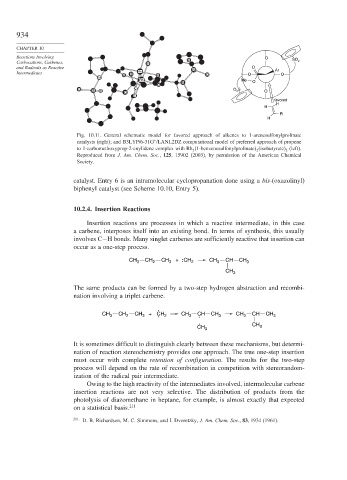Page 958 - Advanced Organic Chemistry Part B - Reactions & Synthesis
P. 958
934
CHAPTER 10
Reactions Involving O
O SO
Carbocations, Carbenes, O 2
and Radicals as Reactive S O Ar
Intermediates O Rh C O O
N O O
Rh Me O
N
O
C C O S
S O 2 O
C
C
favored
H
H
R
H
Fig. 10.11. General schematic model for favored approach of alkenes to 1-arenesulfonylprolinate
catalysts (right); and B3LYP/6-31G /LANL2DZ computational model of preferred approach of propene
∗
to 1-carbomethoxyprop-2-enylidene complex with Rh 2 (1-benzenesulfonylprolinate) 2 (isobutyrate) 2 (left).
Reproduced from J. Am. Chem. Soc., 125, 15902 (2003), by permission of the American Chemical
Society.
catalyst. Entry 6 is an intramolecular cyclopropanation done using a bis-(oxazolinyl)
biphenyl catalyst (see Scheme 10.10, Entry 5).
10.2.4. Insertion Reactions
Insertion reactions are processes in which a reactive intermediate, in this case
a carbene, interposes itself into an existing bond. In terms of synthesis, this usually
involves C−H bonds. Many singlet carbenes are sufficiently reactive that insertion can
occur as a one-step process.
CH 3 CH 2 CH 3 + :CH 2 CH 3 CH CH 3
CH 3
The same products can be formed by a two-step hydrogen abstraction and recombi-
nation involving a triplet carbene.
.
CH 3 CH 2 CH 3 + CH 2 CH 3 CH CH 3 CH 3 CH CH 3
.
.
.
CH 3 CH 3
It is sometimes difficult to distinguish clearly between these mechanisms, but determi-
nation of reaction stereochemistry provides one approach. The true one-step insertion
must occur with complete retention of configuration. The results for the two-step
process will depend on the rate of recombination in competition with stereorandom-
ization of the radical pair intermediate.
Owing to the high reactivity of the intermediates involved, intermolecular carbene
insertion reactions are not very selective. The distribution of products from the
photolysis of diazomethane in heptane, for example, is almost exactly that expected
on a statistical basis. 211
211
D. B. Richardson, M. C. Simmons, and I. Dvoretzky, J. Am. Chem. Soc., 83, 1934 (1961).

